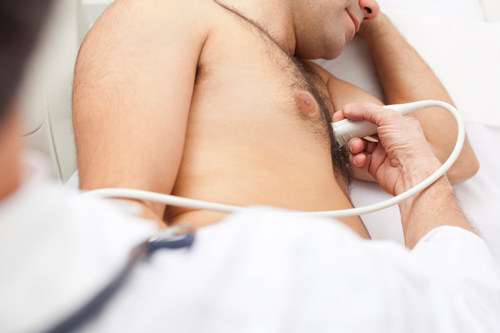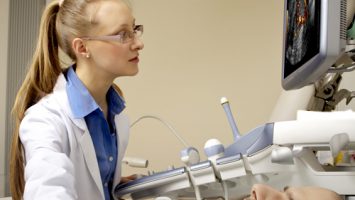
What is an Echocardiogram?
The echocardiogram is a simple, safe non-invasive procedure to have done to diagnose (assess if you have) heart disease.
• There are no needles.
• You will lie on an examination table
• A sonographer will hold a transducer (a device that resembles a computer mouse) against your chest, slowly sliding it back and forth.
You will start usually lying on your side moving to the positions as needed by the sonographer to enable good visibility of the heart. A clear jelly-like substance is applied between the chest and the transducer to improve the contact of the transducer with the skin. You will be asked to roll on your side during the test, or hold your breath for a few seconds. The speed and direction of the blood flow and size heart are measured. The scan screens the four valves for leaks or other abnormalities.
You may hear a “whooshing’ sound much like that of a washing machine if the sonographer chooses to turn this function on. The test takes approximately 30 minutes to complete.
How does the echocardiogram work?
The transducer that’s placed on your chest sends sound waves toward the heart. Like the sonar on a submarine, the sound waves bounce off the heart, and are collected by the transducer. Because it is only sound waves the procedure has no side effects. There is no radiation involved.
These returning sound waves are processed by a computer, assembled into a two-dimensional image of the beating heart, and displayed on a screen (which you will be able to see depending on your position). By aiming the transducer, the technician will be able to image the important cardiac structures.
Why is an echocardiogram performed?
Your referring physician wants all four chambers of the heart, the heart valves, the blood vessels entering and leaving the heart, as well as the thin envelope around the heart assessed. This exam allows the doctors to visualize the anatomy, structure and function of the heart. With the help of the sonographer the interpreting physician assesses heart function and flows to determine acquired and congenital problems; if any. The causes for chest pain, effects of trauma, leaking heart valves, family history of cardiac conditions, following chronic conditions (e.g. kidney disease), and follow up after a surgical procedure are all reasons for having an echocardiogram.
Home Preparation for Echocardiography
•You may eat and drink as usual and take your medications.
•You should not use any cream, lotion, powder or oil on the day of the test.
•Dress simply on the upper half as you will be taking undressing from the waist up.



